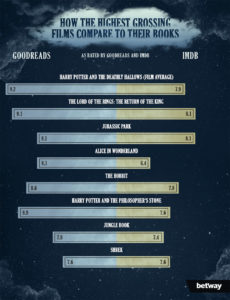The cinematic adaptation of Suzanne Collins’ “The Hunger Games” topped the box office when it debuted in the spring of 2012, grossing more than $155 million in its first three days in cinemas.
With novels, how the reader envisions events is totally reliant on the writer’s descriptive abilities. As a result, when descriptions are adapted from the novel to the big screen, the way these descriptions are converted into real visuals has a profound effect.
It’s not really about perfectly recreating a novel’s plot, as this will always have to be altered in some way to accommodate the change in medium. Nor is it about the casting, as there is rarely a perfect real-life match for a fictional character.
Rather, it’s about delivering the story in the way that fans of the novel would have pictured it in their heads. Good adaptations can even exist between wildly different mediums — as in from movies and books to board games, video games, and even slot machines. Often, the more closely a film’s presentation lines up with readers’ and viewers’ expectations, the more well-received that film will be. Betway Insider will present their arguments below.
Fidelity to the Source Material
Immediately, one’s mind goes to Peter Jackson’s adaptation of “The Lord of the Rings.” The film is critically acclaimed as one of the best book-to-film adaptations of all time — the book it’s based on is one that many have come to love.
Jackson not only captured the scenery of Middle Earth, but he also used language straight from the novels to capture its essence. There’s a certain satisfaction in knowing the story ahead of time – there’s no suspense, and you know how it’ll end. You’re aiming for the visual experience, so hearing the dialogue that you’re familiar with just adds to the enjoyment of the experience.
Unrealistic Expectations
People will always be dissatisfied if they go in to see a film of their favorite book with the hope of complete fidelity to the source material — when they decide in advance that they won’t be satisfied unless the film exactly matches the book.
It should go without saying that books and films are two distinct forms of media. You’ll always be disappointed if you walk into the movie hoping to see everything from the book shown on screen.
Reader-viewers unhappy with the screen adaptations say that they wouldn’t mind having to sit through a 9-hour long movie if it meant everything from the book could be included in the film. But they forget screen adaptations of novels have to reach a very wide audience in order to be profitable.
The longer a film is, the more it costs. At the same time, the longer a film is, the fewer people are going to be able to spare the time to watch it. What’s more, it’s simply unfeasible — the Lord of the Rings is one book, with three movies actually totaling a run time of over 9 hours. The film adaptations still weren’t able to include everything from the books, not even remotely.
That said, Film adaptations do occasionally stray too far; the artistic direction of the film’s directors and producers may have a greater focus on aesthetics at the expense of the plot. For example, the Harry Potter films, particularly the latter ones: the graphics and effects are amazing, but the narrative’s intricacy has vanished, whereas the very first film has almost laughable graphical quality but is almost a perfect adaptation of the first Harry Potter book.
Takeaways
The mix of brilliance, inspiration and the popularity of the novel itself is required for box office success. Still, film directors and producers must also pair these aspects meeting reader and viewer expectations. The basic rule is to strive for the greatest production quality and the most detailed visuals, but never at the expense of the novel’s narrative and the overarching plot.




